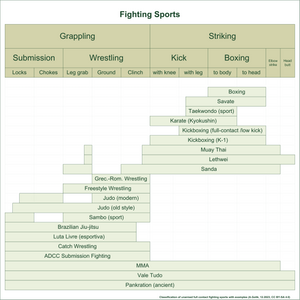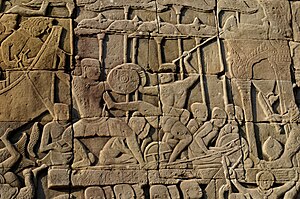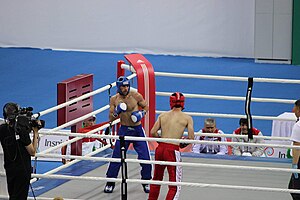Type a search term to find related articles by LIMS subject matter experts gathered from the most trusted and dynamic collaboration tools in the laboratory informatics industry.

A combat sport, or fighting sport, is a contact sport that usually involves one-on-one combat. In many combat sports, a contestant wins by scoring more points than the opponent, submitting the opponent with a hold, disabling the opponent (knockout, KO), or attacking the opponent in a specific or designated technique. Combat sports share a long history with the martial arts.
Some combat sports (and their national origin) include boxing (Greek-British), Brazilian jiu-jitsu (Japanese-Brazilian), catch wrestling (British-American), jujutsu (Japanese), judo (Japanese), freestyle wrestling (British-American), Greco-Roman wrestling (French), karate (Chinese-Okinawan-Japanese), kickboxing (numerous origins, mainly Southeast Asian), Lethwei (Burmese), mixed martial arts (numerous origins), Muay Thai (Thai), sambo (Soviet/Russian), sanda (Chinese), savate (French), taekwondo (Korean), Vale Tudo (Brazilian), pankration (Ancient Greek), luta livre (Brazilian), and folk wrestling (various).


Traditional styles of wrestling exist in most cultures; wrestling can be considered a cultural universal. Boxing contests date back to ancient Sumer in the 3rd millennium BCE and ancient Egypt circa 1350 BCE.[1] The ancient Olympic Games included several combat-related sports: armored foot races, boxing, wrestling, and pankration, which was introduced in the Olympic Games of 648 BCE.
In ancient China, combat sport appeared in the form of lei tai. It was a no-holds barred combat sport that combined boxing and wrestling. There is evidence of similar combat sports in ancient Egypt, India and Japan.[2]
Through the Middle Ages and Renaissance, the tournament was popular. Tournaments were competitions that featured several mock combat events, with jousting as a main event. While the tournament was popular among aristocrats, combat sports were practiced by all levels of society. The German school of late medieval martial arts distinguished sportive combat (schimpf) from serious combat (ernst). In the German Renaissance, sportive combat competitions were known as Fechtschulen, corresponding to the Prize Playing in Tudor England. Out of these Prize Playing events developed the English boxing (or prizefighting) of the 18th century, which evolved into modern boxing with the introduction of the Marquess of Queensberry rules in 1867.
Amateur boxing has been part of the modern Olympic Games since their introduction in 1904. Professional boxing became popular in the United States in the 1920s and experienced a "golden age" after World War II. Professional wrestling was once competitive catch wrestling, a legitimate combat sport in the late 19th and early 20th century, however it has since evolved into athletic theater.
The creation of Brazilian jiu-Jitsu is attributed to the Gracie family of Brazil in 1925 after Asian martial arts were introduced to Brazil. Vale-tudo, wrestling, Muay Thai kickboxing and luta livre gained popularity. Modern Muay Thai was developed in the 1920s to 1930s. Sambo was introduced in the Soviet Union. Modern Taekwondo also emerged after the Japanese occupation of Korea and became an Olympic sport in 2000. Sanshou as part of modern wushu was developed in the People's Republic of China since the 1950s. Kickboxing and full contact karate were developed in the 1960s and became popular in Japan and the West during the 1980s and 1990s. Modern MMA developed out of the interconnected subcultures of Vale Tudo and shoot wrestling. It was introduced in Japan in the form of Shooto in 1985, and in the United States as Ultimate Fighting Championship (UFC) in 1993. The Unified Rules of Mixed Martial Arts were introduced in 2000, and the sport experienced peak popularity in the 2000s. During this period, multiple brands and promotions were established. The most well-known promotion for MMA is UFC.


Combat sports are generally more popular among men as athletes and spectators. For many years, participation in combat sports was practically exclusive to men; USA Boxing had a ban on women's boxing until 1993.[3] A study conducted by Greenwell, Hancock, Simmons, and Thorn in 2015 revealed that combat sports had a largely male audience.[4]
The techniques used can be categorized into three domains: striking, grappling, and weapon usage, with some hybrid rule-sets combining striking and grappling. In combat sports the use of these various techniques are highly regulated to minimize permanent or severe physical damage to each participant though means of organized officiating by a single or multiple referees that can distribute penalties or interrupt the actions of the competitors during the competition. In weapon based sports, the weapons used are made to be non-lethal by means of modifying the striking portions of the weapon and requiring participants to wear protective clothing/armor.
In combat sports, victory is obtained from blows, punches or attacks to the head to a point of physical injury that the opponent is unable to continue.[10] Different forms of combat sport have different rules and regulations into the equipment competitors have to wear. In Amateur boxing seen at the Olympics, competitors are permitted to wear head guards and correctly weighted padded gloves, mouth guards are optional and the canvas floor protection from a hard fall.[11] In sports such as Taekwondo, competitors are permitted to wear a trunk protector, head guard, gloves, groin guard and shin and forearm pads.[12] Professional boxing and MMA are two of the most dangerous combat sports in the world due to the lack of protective gear worn (compared to the protected fists). Competitors in these two sports have the option to wear a mouthguard and must wear suitable gloves. The lack of protective clothing makes competitors vulnerable to concussions and further traumatic head injuries. A scientific experiment, conducted in 2015 by Dr Andrew McIntosh of ACRISP at the Federation University of Australia, tested the impact of seven different head guards in combat sport. The results of the experiment revealed the benefits of the combination of a glove and headguard in maximising the impact energy attenuation.[13] A study conducted by Lystad showed that combat sports with little to no protective gear such as MMA or boxing has an injury incidence rate range of 85.1–280.7 per 1000 athletes in comparison to another striking combat sport like Taekwondo which has a large amount of protective gear such as pads, headgear, mouth guard and gloves, has an injury incidence rate range of 19.1–138.8 per 1000 athletes. This means that injury rates are drastically lowered when protective gear is used.[14]
Gear includes:
In both ancient China and Greece, the most popular sports were probably wrestling, boxing, and combinations thereof (Greek pankration, Chinese leitai). The same might be argued for ancient Egypt, India and Japan. [...] In both ancient China and Greece, the no-holds-barred combat sport (Greek pankration, Chinese leitai) was probably the most popular one.
{{cite journal}}: CS1 maint: multiple names: authors list (link)